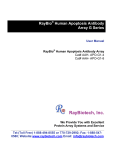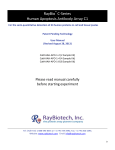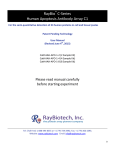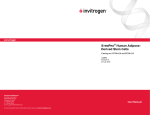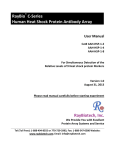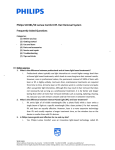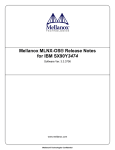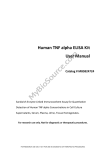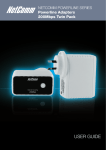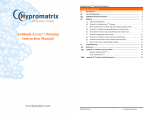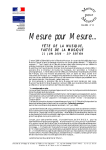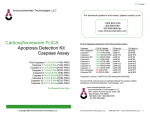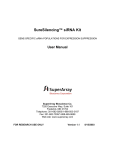Download User Manual - RayBiotech, Inc.
Transcript
RayBio® G-Series Human Apoptosis Antibody Array User Manual (Revised September 29, 2015) Human Apoptosis Array G1 Cat# AAH-APO-G1-4 Cat# AAH-APO-G1-8 Please read manual carefully before starting experiment RayBiotech, Inc. We Provide You with Excellent Protein Array Systems and Service Tel:(Toll Free) 1-888-494-8555 or 770-729-2992; Fax: 1-888-5470580; Website:www.raybiotech.com Email: [email protected] RayBiotech, Inc. Human Apoptosis Array G1 Protocol TABLE OF CONTENTS I. Introduction……..……………………………......... 2 How It Works………………………..……………. 5 II. Materials Provided………………………………… 6 Additional Materials Required…………………… 6 III. Overview and General Considerations…………. 7 A. Preparation of Samples……………………….. 7 B. Handling Glass Chips ………………………….8 C. Incubation……………………………………….. 8 IV. Protocol…………………………………………….. 8 A. Blocking and Incubation……………………….. 8 B. Detection………………………………………… 11 V. Interpretation of Results………………………….. 12 VI. RayBio Analysis Tool…………………………….. 14 VII. Array Map………………………………………….. 15 VIII. Troubleshooting Guide…………………………… 16 IX. Reference List…………………………………….. 17 RayBio® is the trademark of RayBiotech, Inc. RayBio® G-Series Human Apoptosis Antibody Array 1 I. Introduction Apoptosis is the process of programmed cell death that involves a series of biochemical events leading to a characteristic cell morphology and death, including blebbing and changes to the cell membrane, such as loss of membrane asymmetry and attachment, cell shrinkage, nuclear fragmentation, chromatin condensation, and chromosomal DNA fragmentation Apoptotic studies have increased substantially since the early 1990s. In addition to its importance as a biological phenomenon such as cell termination, homeostasis, development and lymphocyte interactions, deregulation of apoptosis has been implicated in many diseases. Excessive apoptosis causes hypotrophy, such as in ischemic damage, whereas an insufficient apoptosis results in uncontrolled cell proliferation, such as HIV progression and cancer development. Apoptosis is mediated by a diverse range of cell signals, both extracellular and intracellular. Extracellular signals may include toxins, hormones, growth factors, nitric oxide or cytokines. Intracellular apoptotic signaling may be induced in response to stress via, heat, radiation, nutrient deprivation, viral infection, hypoxia and increased intracellular calcium concentration or the binding of nuclear receptors by glucocorticoids. These signals may positively or negatively induce apoptosis. Two apoptotic signal transduction pathways in mammals have been reported: the TNF-induced model and the Fas-Fas ligand-mediated model. TNF is the major extrinsic mediator of apoptosis. Most cells in the human body have two receptors for TNF: TNF-R1 and TNF-R2. The binding of TNF to TNF-R1 has been shown to initiate the pathway that leads to caspase activation via the intermediate membrane proteins TNF receptor-associated death domain (TRADD) and Fasassociated death domain protein (FADD). Binding of this receptor can also indirectly lead to the activation of transcription factors involved in cell survival and inflammatory responses. The Fas receptor (also known as Apo-1 or CD95) binds the Fas ligand. The interaction RayBio® G-Series Human Apoptosis Antibody Array 2 between Fas and FasL results in the formation of the death-inducing signaling complex (DISC), which contains the FADD, caspase-8 and caspase-10. Following TNF-R1 and Fas activation in mammalian cells a balance between pro-apoptotic (BAX, BID, BAK, or BAD) and antiapoptotic (Bcl-Xl and Bcl-2) members of the Bcl-2 family is established. This balance is the proportion of pro-apoptotic homodimers that form in the outer-membrane of mitochondrion. The pro-apoptotic homodimers are required to make the mitochondrial membrane permeable for the release of caspase activators such as cytochrome c and SMAC. Control of pro-apoptotic proteins under normal cell conditions of non-apoptotic cells is incompletely understood. Mitochondria are an important site for apoptosis. Mitochondrial proteins known as SMACs (second mitochondria-derived activator of caspases) are released into the cytosol following an increase in permeability. SMAC binds to inhibitor of apoptosis proteins (IAPs) and deactivates them, preventing the IAPs from arresting the apoptotic process and therefore allowing apoptosis to proceed. IAP also normally suppresses the activity of a group of caspases, which carry out the degradation of the cell, therefore the actual degradation enzymes can be seen to be indirectly regulated by mitochondrial permeability. Cytochrome c is also released from mitochondria due to formation of a channel, MAC, in the outer mitochondrial membrane, and serves a regulatory function as it precedes morphological change associated with apoptosis. Once cytochrome c is released it binds with Apaf-1 and ATP, which then bind to pro-caspase-9 to create a protein complex known as an apoptosome. The apoptosome cleaves the pro-caspase to its active form of caspase-9, which in turn activates the effector caspase-3. The tumor-suppressor protein p53 also plays critical role in apoptosis. p53 accumulates in response to DNA damage via interferon-alpha and interferon-beta pathways, which induce transcription of the p53 gene and result in the increase of p53 protein level and enhancement of cancer cell apoptosis. p53 prevents the cell from replicating by stopping the cell cycle at G1, or interphase, to give the cell time to RayBio® G-Series Human Apoptosis Antibody Array 3 repair, however it will induce apoptosis if damage is extensive and repair efforts fail. Any disruption to the regulation of the p53 or interferon genes will result in impaired apoptosis and the possible formation of tumors. A recent report has shown the involvement of IGFBPs (insulin-like growth factor-binding protein) in apoptosis. IGFBP1 protein localizes to mitochondria where it binds to the BAK and hinders BAK activation and apoptosis induction. When IGFBP1 is in a complex with BAK, formation of a proapoptotic p53/BAK complex and apoptosis induction is impaired, both in cultured cells and in liver. In contrast, livers of IGFBP1-deficient mice exhibit spontaneous apoptosis that is accompanied by p53 mitochondrial accumulation and BAK oligomerization. These results identify IGFBP1 as a negative regulator of the BAK-dependent pathway of apoptosis, whose expression integrates the transcriptional and mitochondrial functions of the p53 tumor suppressor protein. RayBio® G-Series Human Apoptosis Antibody Array 4 Here’s how it works Array support Samples Incubation of Sample With arrayed antibody Overnight Supports Cocktail of Biotin-Ab Incubation with Biotinylated Ab Labeled – streptavidin 2 hrs Incubation with 2 hrs Labeled- streptavidin Detection of signals Data analysis and graph RayBio® G-Series Human Apoptosis Antibody Array 5 II. Materials Provided Upon receipt, all components of the RayBio® Human Apoptosis Antibody Array kit should be stored at -200C. At -200C the kit will retain full activity for up to 6 months. Once thawed, the glass chips, HiLyte Plus™-streptavidin, Proteinase Inhibitor and 1X Blocking Buffer should be kept at -200C and all other components should be stored at 40C. Use within three months after reagents have been thawed. Please use within six months after purchase. RayBio® Human Apoptosis Antibody Microarray slides (4 or 8 subarray wells in one slide) 2. Biotin-Conjugated Anti-Apoptosis Antibody cocktail mix (1 vial for 4 wells of each slide, 2 vials for 8 wells of each slide) 3. 1,500X HiLyte Plus™ 555-Conjugated Streptavidin (1 vial) 4. 1X Blocking Buffer (10 ml) 5. 20X Wash Buffer I (30ml) 6. 20X Wash Buffer II (30ml) 7. 2X Cell Lysis Buffer (10 ml) 8. Proteinase Inhibitor ( 1 vial) 9. RayBio® G series antibody array accessory (including slide incubation chamber, Gasket, Protective cover, Snap-on sides and adhesive film) 10. Manual 1. Additional Materials Required Orbital shaker Laser scanner for fluorescence detection Aluminum foil Distilled water Plastic box RayBio® G-Series Human Apoptosis Antibody Array 6 ® Layout of RayBio Human Apoptosis Antibody Array Array Array Blank Blank Barcod Barcod e e 4 arrays in one glass chip 8 arrays in one glass chip III. Overview and General Considerations A. Preparation of Samples For cell lysates and tissue lysates, we recommend using 1X Cell Lysis Buffer to extract proteins from cell or tissue (e.g. using homogenizer). After extraction, spin the sample and save supernatant for experiment. Determine protein concentration. Dilute 2X Cell Lysis Buffer with H2O (we recommend adding proteinase inhibitors to Cell Lysis Buffer before use). Prepare relative concentrated lysate since we recommend diluting lysate at least 5-10 fold with 1X Blocking Buffer for array assay. Protease Inhibitor Cocktail: Briefly spin down the Protease Inhibitor Cocktail tube before use. Add 60 µl of 1X Lysis Buffer into the vial to prepare a 100X Protease Inhibitor Cocktail Concentrate. 2X Cell Lysis Buffer: Cell lysis buffer should be diluted 2-fold with deionized or distilled water before use. Add 20 µl of prepared 100X Protease Inhibitor Cocktail Concentrate (bring the tube to room temperature to thaw the solution before use) into 1.98 ml 1X Lysis Buffer before use. Mix well. We recommend a working concentration of 500-600 µg/ml of total protein for cell lysates and tissue lysates. Since we RayBio® G-Series Human Apoptosis Antibody Array 7 recommend at least 5-10 fold dilution of lysate samples, the original lysate concentration should be at least 2.5 mg/ml. The kit can also be used for serum and plasma samples, as well as conditioned medium. If you experience high background, you may further dilute your sample. B. Handling glass chips The microarray slides are sensitive, do not touch the surface. Hold the slides by the edges only. Handle all buffers and slides with latex free gloves. Avoid breaking glass slide. Handle glass chip in clean environment. C. Incubation Completely cover array area with sample or buffer during incubation, and cover the incubation chamber with adhesive film or plastic sheet protector to avoid drying. Avoid foaming during incubation steps. Perform all incubation and wash steps under gentle rotation. Cover the incubation chamber with adhesive film during incubation, particularly when incubation is more than 2 hours or 50 l of sample or reagent is used. Avoid cross-contamination from overflowing solution to neighboring wells. Several incubation steps such as step 3 (blocking), step 4 (sample incubation), step 8 (biotin-Ab incubation) or step 11 (HiLyte Plus™-streptavidin incubation) may be done at 40C for overnight. Please make sure to cover the incubation chamber tightly to prevent evaporation. RayBio® G-Series Human Apoptosis Antibody Array 8 IV. Protocol A. Blocking and Incubation 1. Take the glass chip out from the box. Let air dry for 60 minutes. 2. Assemble the glass chip into incubation chamber and incubation frame as shown below. (Note: if you slide has been pre- assembled, you can go to step 3 directly). RayBio® G-Series Human Apoptosis Antibody Array 9 3. Add 100 μl 1X Blocking Buffer into each well and incubate at room temperature for 30 min to block slides. Make sure no bubbles are in the well. Note: only add reagents to wells printed with antibodies. 4. Decant Blocking Buffer from each well. Add 70 to 100 μl of each sample to array wells. Incubate arrays with sample at 40C overnight. Dilute sample using 1X Blocking Buffer if necessary. Note: Dilute the lysate at least 10 fold with 1 X blocking buffer to make a total volume of 50 to 100 μl. Make sure there are no bubbles in the wells. Note: The amount of sample used depends on the abundance of Apoptotic molecules. More sample can be used if signals are too weak. If signals are too strong, the sample needs further dilution. Note: Incubation may be done for 2 hours at room temperature. 5. Decant the samples from each well, and wash 5 times with 150 μl of 1X Wash Buffer I at room temperature with gentle shaking. 2 min per wash. Dilute 20X Wash Buffer I with H2O. Completely remove Wash Buffer I in each wash step. Note: avoid solution flowing into neighboring wells. 6. Wash 2 times with 150 μl of 1X Wash Buffer II at room temperature with gentle shaking. 2 min per wash. Dilute 20X Wash Buffer II with H2O. Completely remove wash buffer II in each wash step. RayBio® G-Series Human Apoptosis Antibody Array 10 7. Prepare working solution for biotin-conjugated antibodies. After brief spinning, Add 300 l of 1x blocking buffer to the BiotinConjugated Antibody mix vial. Mix gently. Note: the diluted biotin-conjugated antibodies can be stored at 40C for 2-3 days. 8. Add 70 μl of diluted biotin-conjugated antibodies to each corresponding well. Incubate at room temperature for 2 hours. Note: incubation may be done overnight at 40C. 9. Wash as directed in steps 5 and 6. 10. Add 70 μl of 1,500 fold diluted HiLyte Plus™-conjugated streptavidin (after brief spinning, add 1.5 ml of Blocking Buffer to HiLyte Plus™-conjugated streptavidin tube) to each subarray. Cover the incubation chamber with Adhesive film. Cover the plate with aluminum foil to avoid exposure to light or incubate in dark room. 11. Incubate at room temperature for 1 to 2 hours. Note: incubation may be done at 40C for overnight. 12. Wash with Wash Buffer I twice as directed in steps 5. B. Fluorescence Detection 1. Decant excess Wash Buffer from wells. 2. Disassemble the slide out of the incubation frame and chamber. 3. Place the whole slide in 50 ml centrifuge tube, add enough Wash Buffer I (about 30 ml) to cover the whole slide and gently shake at room temperature for 10 minutes. Decant Wash Buffer RayBio® G-Series Human Apoptosis Antibody Array 11 I. Repeat Wash Buffer I once. Wash with Wash Buffer II (about 30 ml) with gentle shake at room temperature for 10 minutes. Or wash using slide chamber. Rinse the slide with distilled H2O. 4. Remove water droplets by centrifuge at 1,000 rpm for 3 minutes and then let slide dry completely in air at least 20 minutes (protect from light). Make sure the slides are absolutely dry before the scanning procedure. 5. Image the signals using laser scanner such Axon GenePix® using cy3 channel. Note: we recommend scanning slides right after experiment. You also can store the slide at –200C in dark for several days. If you do not have a laser scanner, we can provide service for you. Just simply send your slide to us and we will take care of it. V. Interpretation of Results The following figure shows RayBio® Human Apoptosis Antibody Array using cell lysates from induced and uninduced Jurkat cell line. The images were captured using laser scanner. The biotinconjugated protein produces positive signals, which can be used to identify the orientation and to compare the relative expression levels among the different wells. RayBio® G-Series Human Apoptosis Antibody Array 12 Fig 1. Apoptotic protein profiling in Induced and uninduced Jurkat cell lines Jurkat cells were treated with apoptosis inducer set for 7 hours (10mM Actinomycin D, 2mM Camptothecin, 100mM Cycloheximide, 10mM Dexamethasone, and 100mM Etopiside). 50 g of cell lysate from both induced and uninduced Jurkat cells were incubated overnight with RayBio Human Apoptosis Antibody Array slide. The antibody array slides were then washed and cocktail of biotinylated antibody mix was used to detect apoptosis-related proteins. After incubation with fluorescence dye, the signals were scanned with fluorescence scanner. Array results are shown in Figure A for uninduced Jurkat cells and Figure B for induced Jurkat cells. Representative markers are highlighted in the numbered rectangular boxes. Figure C shows Western Blotting of apoptotic markers (Bcl-2. Caspase-3, HTRA-2) using both induced (0 Hr) and induced (7 Hr) Jurkat cell lysates. RayBio® G-Series Human Apoptosis Antibody Array 13 VI. RayBio® Analysis Tool How to use RayBio® Analysis Tool The signal intensities obtained from laser scanner can simply be imported into our analysis tool. The analysis tool will help you: o Locate your signal intensities to antibody array map Link the protein to website for more detailed information on the particular protein Protein list sorting Average signal intensities Subtract background Normalize the data from different samples Obtain protein level comparison charts among different samples This analysis tool is very simple and affordable, which will not only assist in compiling and organizing your data, but also reduces your calculations to a “copy and paste” step. If you do not use our RayBio® Analysis Tool, you can locate the Apoptosis by referring to RayBio® Human Apoptosis Antibody Array. Normalization and comparison For biomarker discovery or for analysis of large number of arrays, great attention must be paid to the normalization. Our apoptosis antibody array design includes controls for normalization and comparison of arrays performing in different membranes and different experiments. Positive control. Positive control is biotinylated protein. It can be used to normalize the streptavidin incubation step. If the positive signals from different array membranes are similar, positive control is a simple and effective way for normalization. Negative control. Negative control is BSA. Normally, it should only give a background reading. RayBio® G-Series Human Apoptosis Antibody Array 14 V. Array Map RayBio® Human Apoptosis Antibody Array G series 1 A Pos 1 B Pos 2 B Pos 3 D Neg E Neg F G H I J K L M bad bax bcl-2 bcl-w BID BIM Caspase3 caspase8 2 Pos 1 Pos 2 Pos 3 Neg Neg bad bax bcl-2 bcl-w BID BIM Caspase3 caspase8 3 CD40 CD40L cIAP-2 cytoC DR6 Fas FasL neg HSP27 HSP60 HSP70 HTRA IGF-I 4 CD40 CD40L cIAP-2 cytoC DR6 Fas FasL neg HSP27 HSP60 HSP70 HTRA IGF-I 5 IGF-II IGFBP-1 IGFBP-2 IGFBP-3 IGFBP-4 IGFBP-5 IGFBP-6 IGF-1sR livin p21 p27 p53 SMAC 6 IGF-II IGFBP-1 IGFBP-2 IGFBP-3 IGFBP-4 IGFBP-5 IGFBP-6 IGF-1sR livin p21 7 Survivin sTNF-R1 sTNF-R2 TNF-alpha TNF-beta TRAILR-1 TRAILR-2 TRAILR-3 TRAILR-4 XIAP p27 Neg p53 Neg SMAC Neg 8 Survivin sTNF-R1 sTNF-R2 TNF-alpha TNF-beta TRAILR-1 TRAILR-2 TRAILR-3 TRAILR-4 XIAP Neg Neg Neg We also offer sample testing service and Custom Human Apoptosis Antibody Arrays at an affordable price. For more information, please visit our website, www.raybiotech.com. RayBio® G-Series Human Apoptosis Antibody Array 15 VI. Troubleshooting guide Problem Cause Weak signal Inadequate detection Check laser power Check PMT parameters Inadequate reagent volume Improper dilution Check pipettor Ensure correct preparation Inadequate incubation times Ensure sufficient incubation Time Incubate sample overnight Low protein concentration in sample Don’t make too low dilution Concentrate sample Recommendation Improper storage of kit High Background Excessive biotinylated antibodies Excessive streptavidin Make sure correct amount of streptavidin Inadequate detection Check laser power Check PMT parameters Unclean environment such as dust Work in clean environment Increase wash time Use more wash buffer Insufficient wash Uneven Signal Store kit at recommended temperature Make sure correct amount of antibodies Bubbles formed during incubation Avoid bubble formation during incubation Arrays are not completed Covered by reagent Completely cover arrays with solution RayBio® G-Series Human Apoptosis Antibody Array 16 VII. Reference List 1. 2. 3. 4. 5. 6. 7. 8. 9. 10. 11. 12. Zaparta JM, Krajewska M, Krajewski S, Huang RP, Takayama S, Wang HG, Adamson E, and Reed JR (1998). Expression of multiple apoptosis-regualtory genes in human breast cancer cell lines and primary tumors. Breast Can Res &Treat. 47: 129-140. Huang RP, Huang R, Fan Y, and Lin Y (2001) A novel method for highthroughput protein profiling from conditioned media and patient’s sera. Ana. Biochem. 294(1):55-62. Lue JI, and George DL (2007). Hepatic IGFBP1 is a prosurvival factor that binds to BAK, protects the liver from apoptosis, and antagonizes the proapoptotic actions of p53 at mitochondria. Genes & Dev. 21: 30953109. Thompson, CB (1995). Apoptosis in the pathogenesis and treatment of disease. Science. 267 (5203): 1456–62. Brüne B (2003). Nitric oxide: NO apoptosis or turning it ON? Cell Death Differ. 10 (8): 864–9. Fesik SW, Shi Y (2001). Controlling the caspases. Science. 294 (5546): 1477–8. Dejean LM, Martinez-Caballero S, Manon S, and Kinnally KW (2006). Regulation of the mitochondrial apoptosis-induced channel, MAC, by BCL-2 family proteins. Biochim. Biophys. Acta. 1762 (2): 191–201. Wajant H (2002). The Fas signaling pathway: more than a paradigm. Science. 296 (5573): 1635–6. Chen G, and Goeddel DV (2002). TNF-R1 signaling: a beautiful pathway. Science. 296 (5573): 1634–5. Murphy KM, Ranganathan V, Farnsworth ML, Kavallaris M, and Lock RB ( 2000). Bcl-2 inhibits Bax translocation from cytosol to mitochondria during drug-induced apoptosis of human tumor cells. Cell Death Differ. 7 (1): 102–11. Susin SA, Lorenzo HK, and Zamzami N (1999). Molecular characterization of mitochondrial apoptosis-inducing factor. Nature. 397 (6718): 441–6. Nagata S (2000). Apoptotic DNA fragmentation. Exp. Cell Res. 256 (1): 12–8. RayBio® G-Series Human Apoptosis Antibody Array 17 Note: RayBio® is the trademark of RayBiotech, Inc. Apoptosis antibody arrays are RayBiotech patent-pending technology. This product is intended for research only and is not to be used for clinical diagnosis. Our produces may not be resold, modified for resale, or used to manufacture commercial products without written approval by RayBiotech, Inc. Under no circumstances shall RayBiotech be liable for any damages arising out of the use of the materials. Products are guaranteed for three months from the date of purchase when handled and stored properly. In the event of any defect in quality or merchantability, RayBiotech’s liability to buyer for any claim relating to products shall be limited to replacement or refund of the purchase price. ECL™ is the trademark of Amersham Pharmacia Biotech. HiLyte Plus™ is the trademark of AnaSpec, Inc. GenePix® is a registered trademark of Molecular Devices, Inc. RayBio® G-Series Human Apoptosis Antibody Array 18 This product is for research use only. ©2015 RayBiotech, Inc. RayBio® G-Series Human Apoptosis Antibody Array 19




















